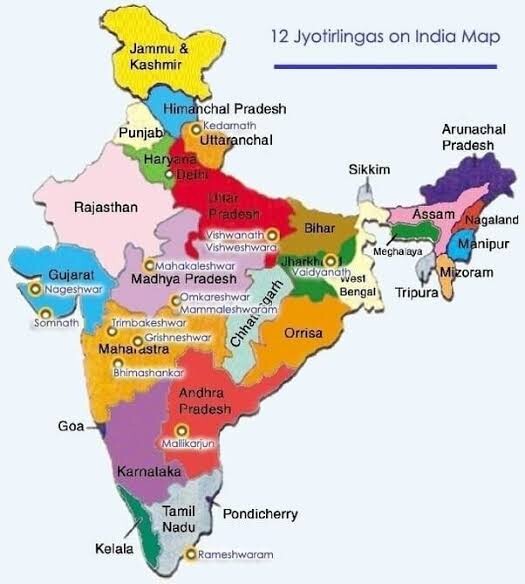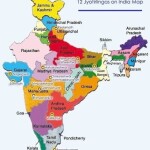- Somnath - Gujarat
- Nageshwar - Daarukavanam in Gujarat
- Bhimashankar - Pune in Maharashtra
- Grishneshwar - Aurangabad in Maharashtra
- Vaidyanath - Deoghar in Jharkhand
- Mahakaleshwar - Ujjain in Madhya Pradesh
- Omkareshwar - Khandwa in Madhya Pradesh
- Kashi Vishwanath - Varanasi in Uttar Pradesh
- Kedarnath - Kedarnath in Uttarakhand
- Rameshwaram - Rameshwaram Island in Tamil Nadu
- Mallikarjuna - Srisailam in Andhra Pradesh
1. Somnath Jyotirlinga, Gujarat

One of the most famous Jyotirlingas in India. Somnath is considered to be the first one that was acquired by the deity. This jyotirling in Gujrat is a highly revered pilgrimage site in the country.With a rather decorative shrine of Lord Shiva, the architecture of the temple complex is very Chalukya-inspired. Legend also suggests that Lord Shiva apparently visited this shrine. It does have an intriguing factor as there are many stories connected to this particular shrine of Lord Shiva. Visit the jyotirlinga in India to know more about its hidden tales!
The Legend behind Somnath Jyotirlinga- Gujarat
Moon or Chandra was married to 27 daughters of Daksha, son of Brahma. But Chandra only gave attention to one named Rohini, which upset the others. Daksha didn’t like this behavior of Chandra and cursed him to lose all his light. This led to darkness in the entire world. All Gods came together to find a solution and asked Chandra to pray to Lord Shiva. After worshiping, Shiva appeared and blessed Chandra with the ray of light back again.People believe that on moonless nights, Chandra comes and dips in the holy water to shine again. Thus, the name ‘Sommeswar’ or Jyotirlinga came into existence.
2. Nageshwar - Daarukavanam in Gujarat

Nageshwar is one of the popular Jyotirlinga temples in India. Thousands of devotees visit the temple of Nagnath, round the year, to seek blessings from the holy shrine of Nageshwar Mahadev located in an underground sanctum.This Jyotirlinga holds special significance as it symbolises protection from all types of poison. It is believed that those who worship at this temple become free of all poisons
The legend behind Nageshwar Jyotirlinga- Gujarat
Supriya, a devotee of Lord Shiva resided in Dwarka. She was attacked by a demon called Daaruka and eventually, started praying to Shiva. He appeared, killed Daaruka, and freed Supriya from him. Thus, this place became the abode of Lord Shiva.
3. Bhimashankar - Pune in Maharashtra

On the banks of River Bhima there lies, Bhimashankar temple- a marvellous black rock structure, with Nagara architectural pattern. Surrounded by a wildlife sanctuary of the same name, the jyotirlinga here is believed to be built by Bheema- Kumbhakarna’s son. Huge number of pilgrims visit this shrine, round the year, especially during Maha Shivratri. The place turns into a carnivalesque haven during Maha Shivratri with devotees coming over from various parts of the state Devotees visiting Bhimashankar temple, also see Kamalaja temple- an incarnation of Parvati, located close by. This is one of the most popular jyotirlinga in India.
The legend behind Bhimashankar Jyotirlinga- Pune in Maharashtra
Karkati once told his little boy, Bhima that his father, Kumbharakhan (the brother of Ravana) was killed by an avatar (reincarnation) of Rama. He raged with anger and decided to take revenge for his father’s death. He worshiped Brahma to gain worldly powers but instead misused to harm people and also ask them to worship him.
He took Shiva’s devotee Kamarupeshwar into his custody and was about to kill him when Lord Shiva appeared and killed Bhima, taking away all his powers. Gods asked Shiva to stay here to protect people and empower them against the demons like Bhima.
4. Trimbakeshwar - Nashik in Maharashtra

Located on the banks of the River Godavari, near Brahmagiri Mountain, Nasik. Trimbakeshwar holds an eminent spiritual importance as it is among the four Hindu cities where the Kumbh Mela is held every 12 years.
The temple has a very unique shape and is famous all over the world. The three pillars placed inside the temple represent the three powerful and supreme Gods, namely, Brahma, Vishnu, and Mahesh. It is said that there is a temple built at the site where Lord Rama performed the shraddha ceremony of his forefathers
The legend behind Trimbakeshwar - Nashik in Maharashtra
Once there was a sadhu named Gautam Rishi who lived with his wife, Ahilya. Due to his devotion, he pleased Shiva who blessed Gautam with a pit to create as much food and grains as he wanted. His rivals got jealous of him and in anger, sent a dead cow to the pit. Gautam, in sadness and agony, called Lord Shiva who appeared and blessed the place with the Ganga River to wash away the sins and eventually started living here.
5. Grishneshwar - Aurangabad in Maharashtra

The Ghrishneshwar Jyotirlinga is located in a village called Verul, which lies 20 km from Daulatabad, near Aurangabad in Maharashtra. Located near this temple is the famous tourist site – Ajanta & Ellora caves. This temple was built by Ahilyabai Holkar who also rebuilt the Kashi Vishwanath Temple in Varanasi. The Ghrishneshwar temple is also known by other names like Kusumeswarar, Ghushmeswara, Grushmeswara and Grishneswara. The temple complex is quite exciting with very beautiful carvings, sculptures and more. It is every bit impressive and you will be left spellbound by the temple structure.
The legend behind Grishneshwar- Aurangabad in Maharashtra
There was a woman named Kusum who worshiped Lord Shiva by immersing him in the water tank. This unique style of worship was not understood by her husband, who also had other wives. She was rejected by the people of her village too. In agony, her husband killed her son but Kusum continued with her prayers. One day, Lord Shiva appeared in front of her along with her son out of the water tank, and therefore, the Jyotirlinga stayed here forever.
6. Vaidyanath - Deoghar in Jharkhand

Vaidyanath Temple is also known as Vaijnath or Baidyanath. It is located at Deogarh Santal Parganas region of Jharkhand in the. A highly revered jyotirlinga among the 12 Jyotirlinga names in the country, Vaidyanath or Baidyanath or Vaijinath is also one among the 52 shakti pethas shrines of Sati of Hindu religion. Vaidyanath in Jharkhand has a very interesting story of origin. Actually, it is quite popular too. The tale goes like this, Ravana, a staunch believer of Lord Shiva prayed for years to invite him to Lanka
The legend behind Vaidyanath Jyotirlinga - Deoghar in Jharkhand
Ravana was Shiva’s ardent devotee but as he lived in Lanka, he knew Shiva doesn’t reside here. So, to protect his kingdom, he started praying to Lord Shiva. One day, Shiva appeared and asked him his wish to which Ravana asked a lingam to be placed in his kingdom. Shiva warned him that if he kept the lingam once on the ground, it would stay there forever.He agreed and on his way back asked a local shepherd to hold it and not place it on the ground until he returned. The shepherd said if he does not come on time, he will leave it. Ravan failed and the shepherd kept the lingam on the ground where the Vaidyanath Jyotirlinga Temple is situated today.
7. Mahakaleshwar - Ujjain in Madhya Pradesh

Mahakaleshwar Temple is located on the banks of the Kshipra River, in the dense Mahakal forest in Ujjain, Madhya Pradesh. This Jyotirlinga in Madhya Pradesh is an important pilgrimage site in Central India. Mahakaleshwar Jyotirlinga is also recognised as one of the seven mukti sthas in the country. The word Mahakaal is a combination of two words Maha (virtue of Lord Shiva) and Kaal (time).
The legend behind Mahakaleshwar Jyotirlinga- Deoghar in Jharkhand
Chandrasena was an ardent devotee of Shiva and ruled a kingdom. One day, king Ripudamana attacked the kingdom with the help of a demon named Dushan, who has the power to become invisible. Chandrasena feared defeat and prayed to Lord Shiva for help. Shiva appeared and promised to stay at the kingdom of Mahakaleshwar to protect it from Dushan and other demons. People still believe that Lord Shiva resides here.
8. Omkareshwar - Khandwa in Madhya Pradesh

Resided on an Om-shaped island called Shivapuri on the banks of Narmada River, Madhya Pradesh. Denoting the Lord of the Om Sound. Omkareshwar Jyotirlinga is a revered Hindu temple, which is the center of intense faith. The Omkareshwar temple is a magnificent three-storied temple supported by large pillars made up of carved granite stone. Omkareshwar is a popular jyotirlinga that literally translates to the Lord of the Om Sound. The temple is known to have immense mythological significance. It is believed that there was a war between Devas and Danavas. As the Devas prayed to Lord Shiva, happy with their dedication, Lord Shiva chose their side and appeared as Omkareshwar to help them triumph over the evils.
The legend behind Omkareshwar Jyotirlinga- Khandwa in Madhya Pradesh
Demons attacked the kingdom of king Mandhata once and a mighty mountain requested Lord Shiva to help the people. Mandhata also worshiped Shiva a lot. So, Shiva helped them and due to the king’s devotion got pleased and decided to stay at Omkareshwar forever.
9. Kashi Vishwanath - Varanasi in Uttar Pradesh

The Kashi Vishwanath Temple is located in the most revered site in the world- Kashi! It is situated amidst the crowded lanes of the holy city of Banaras (Varanasi). More than the Ghats and Ganga of Varanasi, Renowned as Golden Temple in Varanasi, Kashi Vishwanath is a popular one on the Jyotirlinga temples list. Constructed in 1780 by Maharani Ahilyabai Holkar- a Maratha Monarch, this Jyotirlinga is a significant religious place for the Hindus. Devotees believe that Lord Shiva resided here and offered liberation and happiness to all. It is also considered as one of the first Jyotirlingas in the country which showcased its power over other Gods, broke through Earth’s surface and moved towards heaven. It’s among the most sought after 12 Jyotirlingas in India.
The legend behind Kashi Vishwanath Jyotirlinga - Varanasi in Uttar Pradesh
Kashi is known to be the oldest place on earth. Also, it is the abode of all the lords – Brahma, Vishnu, and Mahesh (Shiva). People believe Kashi to be the place to get rid of all your sins and attain salvation. Thus, it is believed that Shiva created this place and the city that can never be destroyed.
10. - Kedarnath in Uttarakhand

Kedarnath is another famous jyotirlinga in India that is inaccessKedarnath ible most of the year. Owing to a very rough climate with cold weather and snowfall, the temple remains closed for the devotees. People believe on visiting Kedarnath temple and bathing the jyotirlinga, one can get rid of all unhappiness, ill luck, and misfortunes. Trekking up to Kedarnath is moderately difficult and people use walking sticks or ride on mules or dolis. The Samadhi of Shankaracharya- the famous Hindu saint is located just behind the main Kedarnath temple.
The legend behind Kedarnath Temple - Uttarakhand
In the Hindu epic, Mahabharata, the Pandavas (5 brothers) wanted to let go of all their sins to go to heaven and started their journey to find such a place. They worshiped Lord Shiva and found the shrine, which today we call Kedarnath Jyotirlinga Shiva Temple. Soon, they found Shiva in a vast triangular-shaped ‘Jyotirlinga’
11. Rameshwaram - Rameshwaram Island in Tamil Nadu

Rameshwaram Jyotirlinga is believed to be worshipped by Lord Rama, after his phenomenal victory over Ravana. Known as the southernmost jyotirlingas in the country, the temple is surrounded by sea and boasts of its beautiful architecture, decorated corridors, and 36 theerthams. Also recognised as the Varanasi of the South, the Rameshwaram Jyotirlinga is also one of the most-visited holy places in the country. Besides visiting the Rameshwaram Jyotirlinga, devotees often also visit Dhanuskhodi beach to seek the blessings of Lord Rama. You should visit the temple to know more about the background story of the jyotirlinga.
The legend behind Rameshwaram Jyotirlinga -Tamil Nadu
There are two Jyortirlingas at Rameshwaram, one was brought by Lord Hanuman and the other by Mother Sita. These Jyotirlingas are also worshiped in the same order. Also, this was the place where Lord Rama worshiped Vishnu after killing Ravana.
12. Mallikarjuna - Srisailam in Andhra Pradesh

Popular as Kailash of the South among the other 12 Jyotirlingas in India; Mallikarjuna jyotirlinga temple is located atop Shri Saila Mountain, on the banks of River Krishna. The last of the 12 jyotirlingas in India, the Mallikarjuna Jyotirlinga temple is perched on the hilltop of the Shri Saila Mountain. You can view theRiver Krishna from the temple which is decked up with excellent architecture and sculptures. A pilgrimage to these jyotirlingas in India would actually be the best spiritual journey that you can indulge in. It is every bit holistic and rewarding.
The legend behind Mallikarjuna Jyotirlinga - Andhra Pradesh
One time, Shiva and Parvati were not able to decide which son to marry first, Ganesh or Kartikeya. To solve this, they asked both their sons to go around the world and whosoever came first will be married first to Riddhi and Siddhi. While Kartikeya went to take the round around the world, Ganesha started encircling Parvati and Ganesha as for him, they were his world. This gesture was loved by both Lord Shiva and Parvati and they decided to marry Ganesha first.
Out of frustration, Kartikeya went far to a mountain named ‘Kravunja’ and resided there. Knowing this, Shiva and Parvati decided to pay a visit to their son Kartikeya and Jyotirlings came into existence as the spot where they met Kartikeya.









